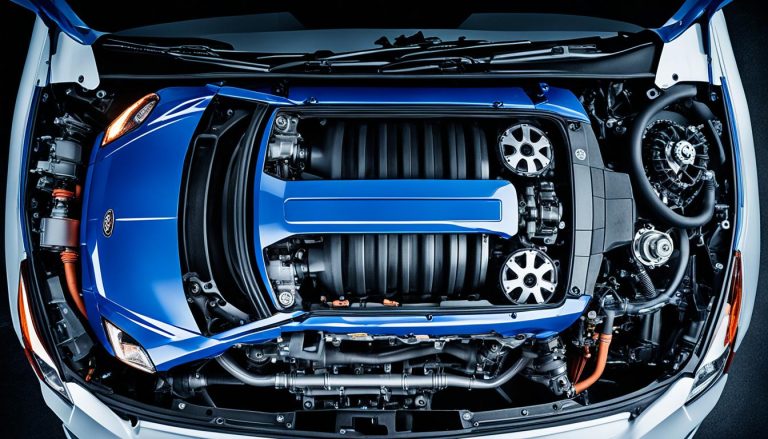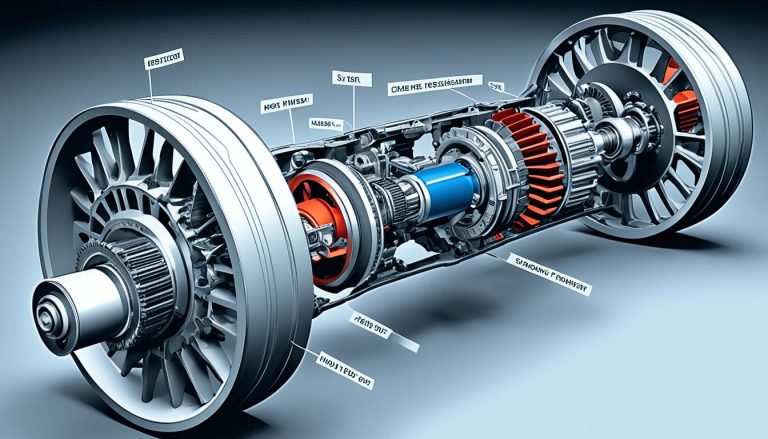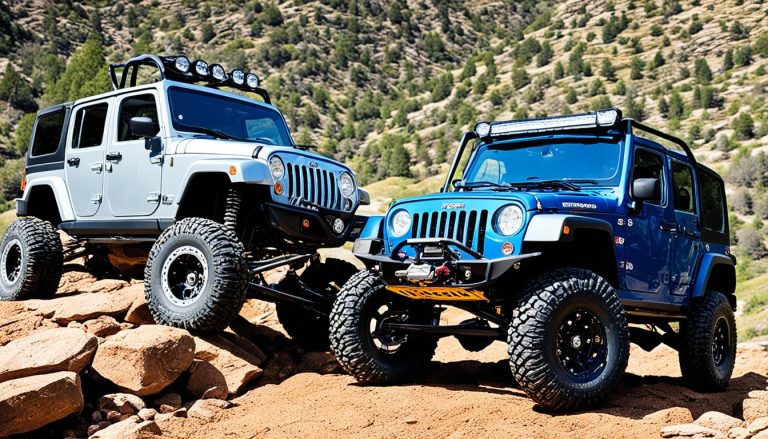Ford Locking Rear Axle vs Limited Slip Duel
If you find yourself weighing the benefits of a ford electronic locking rear axle against the merits of a limited slip differential for your Ford truck, you’re not alone. These are two key components that can dramatically influence the performance of your Ford truck differential across various terrains. On one hand, the electronic differential is a modern solution designed to lock both rear wheels, ensuring that they turn in sync for maximum traction when you’re off-roading or stuck in a tough spot. On the other hand, a limited slip axle works to automatically redistribute torque to the wheel with the most grip, which is especially handy on slick or uneven roads where traction is inconsistent.
Your choice between a locked differential and a limited slip differential could mean the difference between spinning your wheels and confidently navigating through challenging conditions. Each system has its championed scenario where it excels — the locker thrives in extreme off-road situations, whereas the limited slip offers a more subtle enhancement that’s continually at work, making it suitable for daily drives as well as impromptu encounters with less-than-ideal roads.
Key Takeaways
- The Ford electronic locking rear axle directly controls wheel spin by locking both rear wheels together for superior traction when you need it most.
- A limited slip differential can be ideal for on-road performance, providing ongoing traction without the need for driver intervention.
- Choosing the right Ford truck differential can significantly enhance your vehicle’s performance in various driving conditions.
- Understanding how an electronic differential works in comparison to a limited slip axle is key for making an informed decision that suits your driving needs.
- The debate between a locked differential and a limited slip differential often centers around the need for on-demand traction versus consistent, passive traction enhancement.
Understanding the Ford Locking Rear Axle: Benefits and Operations
When considering how to enhance your Ford truck’s performance, especially in challenging driving conditions, knowing the ins and outs of your vehicle’s differential can be highly beneficial. The Ford electronic locking rear axle, a more advanced form of the traditional differential system, offers distinct advantages and operation modes that cater to off-road enthusiasts and those seeking reliable traction in unpredictable environments.
Electronic Locking vs Standard Differentials
What sets the Ford electronic locking differential apart from a standard differential? Essentially, it’s the ability to toggle between an open differential state, useful for normal driving conditions that require different wheel speeds, and a locked differential state, which delivers equal power to both wheels for maximum traction. This innovation is particularly useful when you encounter uneven terrain where the risk of one wheel spinning without traction is high. A locked differential ensures that your Ford truck won’t lose momentum when it’s needed the most.
When to Use the Ford Electronic Locking Rear Axle
Knowing when to engage the electronic locking differential can be the key to navigating through tough spots without a hitch. It’s designed for use during strenuous conditions, such as off-road trails or surfaces with varying levels of traction such as mud or snow. The beauty of this system is its ability to be engaged on the fly, providing immediate improvement in traction, contrasting with other differential lockers which may necessitate coming to a stop before activation.
Cost vs Performance: Is the Electronic Locker Worth the Investment?
Is upgrading to a Ford electronic locking rear axle a cost-effective performance upgrade? Many Ford truck drivers would say “yes,” especially when considering the vastly improved capabilities in a variety of settings. While there’s an upfront investment, the potential for enhanced control and fewer instances of getting stuck off-road may save you money in the long run. This differential proves to be a prudent enhancement, acting as a form of traction control ready to tackle any situation you might face on your driving adventures.
Ford Limited Slip Differential Explained
When it comes to optimizing the performance of your Ford truck, understanding the capabilities of a limited slip differential is key. Unlike standard differentials, the Ford limited slip axle packs a clever mechanical setup that redistributes power to the wheel that has the most grip. This technology is particularly beneficial for maintaining traction in slippery conditions, such as wet or icy roads, where typical differentials might fall short.
Arguably, you might be considering the pros and cons of a limited slip vs locker. Here’s an insight: the limited slip differential is all about upgrading your driving experience with a balance between handling and traction. It’s designed to kick in without any input needed from you, subtly adjusting the power distribution as you maneuver around obstacles and across slick surfaces.
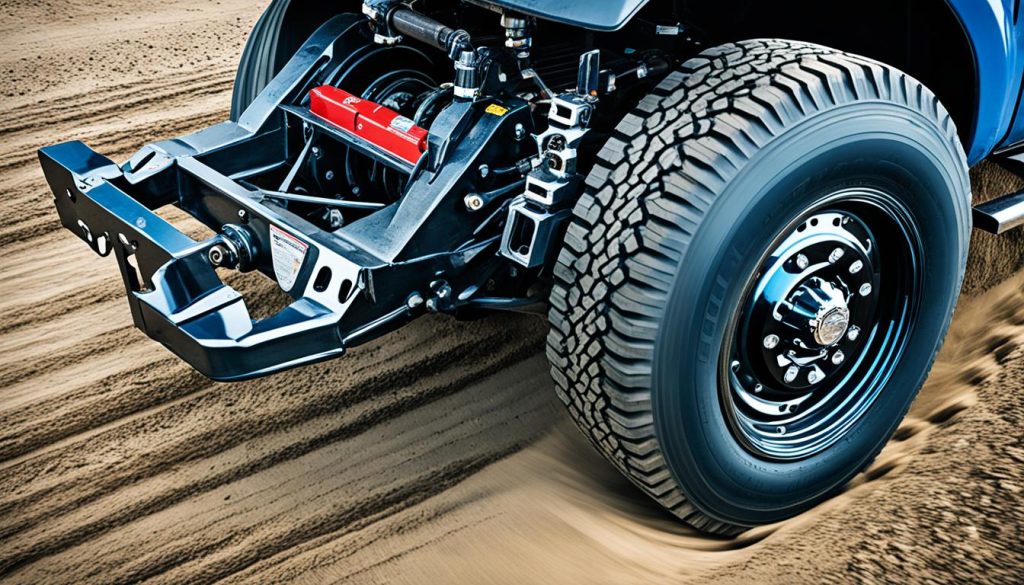
The table below outlines the fundamental differences between a limited slip differential and a locker, allowing you to make an informed choice based on your driving needs:
| Feature | Ford Limited Slip Differential | Locker |
|---|---|---|
| Operation | Automatically transfers power to the wheel with traction | Manually locks to provide equal power to both wheels |
| Preferred Conditions | Best suited for on-road driving | Ideal for off-road or extreme conditions |
| Traction Enhancement | Provides consistent traction without driver intervention | Offers maximum traction on demand |
| User Control | No driver input needed; automatic function | Driver must engage the locking mechanism |
So, whether you’re tackling daily commutes or preparing for an adventure that may lead you off the beaten path, understanding the functionalities and benefits of the Ford limited slip differential is invaluable. Recognizing when your vehicle might benefit from this smart axle system can enhance both your safety and driving pleasure on various terrains.
Ford Electronic Locking Rear Axle vs Limited Slip: Comparing Traction and Control
When you put the Ford electronic locking rear axle head to head with the limited slip differential, it’s like comparing the strength of an anchor to the agility of a rudder. Let’s dive into their performance nuances to determine which is best suited for your Ford truck’s differential needs.
For starters, it’s crucial to understand how each system tackles mixed traction performance. Now, envision you’re facing a daunting climb on a rugged trail where one tire finds grip while the other grapples with loose gravel. With the electronic locking rear axle, you’re commanding both wheels to move at unison—seamlessly delivering that brute strength needed to conquer the path. The limited slip differential, while deft in its operation, offers assistance to the struggling wheel rather than a full-force lock, which sometimes isn’t enough on severe inclines or complex terrain.
Performance in Mixed Traction Conditions
Consider our Ford truck’s performance as it faces these rugged trails. The electronic locker engagement ensures that the power isn’t merely suggested to your wheels—it’s commanded with authority. This is a critical feature when you find yourself amidst circumstances where grip is a rare commodity
Electronic Locker Engagement Speed vs 4×4 Activation
Time is of the essence, especially when you face unpredictable terrains. With a 4×4 system, there’s often a slight pause needed—a moment where the vehicle must adjust to provide additional traction. The beauty of an electronic locking rear axle lies in its prompt response, giving you the advantage when you need rapid assistance without breaking stride.
Addressing Myths About Limited Slip Differentials on the Road
Some might tell you that limited slip axles will cause your truck to skate and slide come wintertime, but in reality, this is one of the many limited slip axle myths. When rubber meets icy road, the limited slip differential is the unsung hero, mitigating slippage by strategically allocating power to the wheel with the most grip, and offering stability akin to a figure skater’s delicate yet precise maneuver.
In this contest between grit and grace, between the firm hand of the differential locker and the artful balance of the limited slip, the differential locker advantages may make it a preferable option for those challenging moments. It’s not just about moving forward; it’s about mastering the moment—your Ford is ready.
| Feature | Ford Electronic Locking Rear Axle | Limited Slip Differential |
|---|---|---|
| Traction Performance | Equal power to both wheels | Diverts power to the wheel with grip |
| Engagement Speed | Rapid and on-the-go | Generally requires wheel speed variation |
| Myth | N/A | Limited slip causes rear-end drift on ice |
| Best Used For | Steep inclines, off-road | On-road, slippery conditions |
Maximizing Your Ford Truck’s Capability in Adverse Conditions
When the weather outside turns frightful, Ford truck owners can take solace in the technological advancements that keep their vehicles formidable against challenging elements. Particularly, the Ford electronic locking rear axle has redefined stability control and safety in snow and ice, assuring drivers a much-needed peace of mind during the winter months.
Real-World Applications of Electronic Differential Lockers
Imagine battling through a blizzard, your Ford’s tires churning through thick layers of snow. Here, electronic differential lockers are not just a feature—they’re a lifeline. Activating the locker distributes power equally to both rear wheels simultaneously, empowering you to power through conditions that would have otherwise left you immobile.
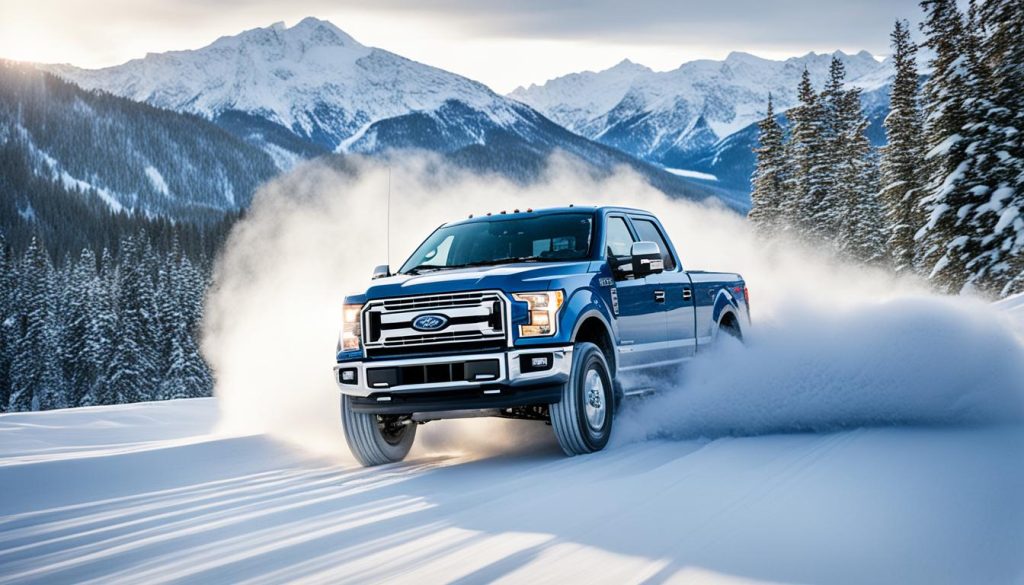
From navigating the slickest mud trails to climbing inclines blanketed in snow, the locker is a testament to the Ford truck capability to tackle adverse driving conditions without breaking a sweat. Where others see an impasse, your Ford sees an adventure.
Ensuring Safety and Stability in Snow and Ice
Slippery roads and unpredictable winter weather can make driving hazardous. The inclusion of an electronic locking rear axle in your Ford truck provides more than just traction—it’s a versatile tool promoting steadfast stability.
When the road is uneven or icy, and the tires struggle to hold ground, the locker engages to ensure both wheels spin in unison, reducing skid risks and enhancing directional control. So even when Mother Nature throws her worst your way, your Ford remains sure-footed, upholding the highest standards of safety in snow and ice.
Harness the full potential of your Ford truck, no matter what the skies have in store. With these intelligent features at your fingertips, you’re equipped not just to endure, but thrive in the face of adversity. Embrace the capability, control, and confidence your Ford truck offers, and make the most out of every drive.
Electronic Differential Lockers vs Limited Slip in Off-Roading Adventures
When you’re gearing up for an off-roading adventure, the differential technology you choose can have a significant impact on your vehicle’s performance. In particular, the off-roading differential performance varies greatly between electronic differential lockers and limited slip differentials, and this choice can be further influenced by your rig’s long wheelbase and chassis rigidity. Let’s delve into how these factors interact and influence the capabilities of your off-road vehicle.
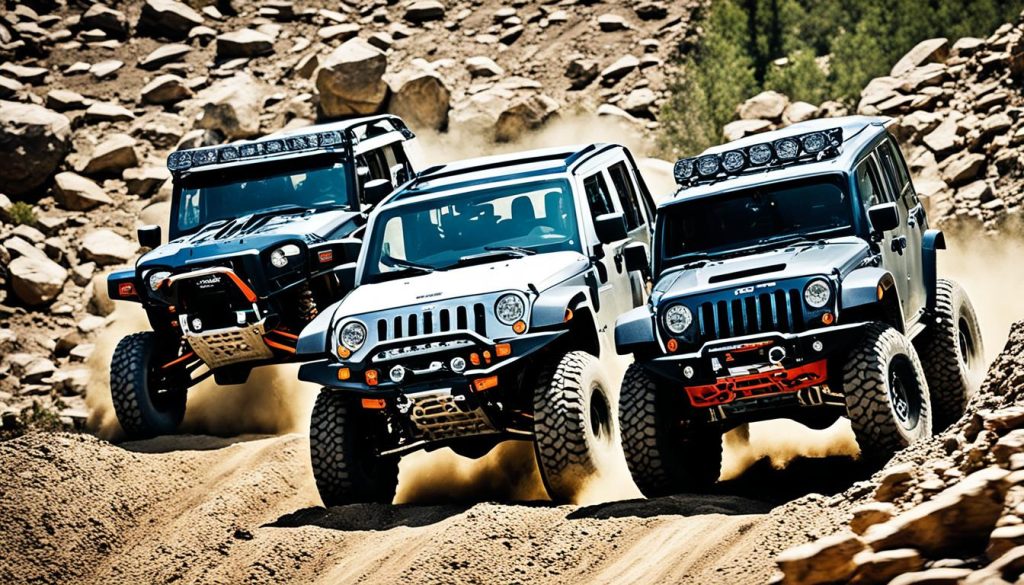
The Impact of Long Wheelbase and Chassis Rigidity on Differential Performance
Those of you with a passion for off-roading understand that a vehicle’s chassis and wheelbase dimensions play a role not just in stability and ride comfort but also in traction capabilities. A long wheelbase can mean better weight distribution and improved stability—qualities that are beneficial on uneven terrain. However, a rigid chassis may sometimes work to your disadvantage, as it can limit the articulation of the suspension, particularly when navigating over large obstacles or through ditches.
At such moments, the advantages of an electronic locking differential become apparent. This differential can lock the wheels together, ensuring that both wheels drive with full force, even if one is in the air. As a result, any potential traction is used to its fullest. Here’s a table that helps articulate the differences between the two differential types in the context of off-roading:
| Factor | Electronic Locking Differential | Limited Slip Differential |
|---|---|---|
| Wheel Spin Prevention | Locks wheels to prevent any spin | Redistributes torque to limit spin |
| Chassis Rigidity Adaptation | Performs well with rigid chassis | Performance can be hindered without wheel articulation |
| Effect on Traction | Maximizes traction in asymmetrical conditions | Enhances traction but may not provide enough force in extreme conditions |
| Preferred Terrain | Best for extreme off-road obstacles | Optimal for mild off-road and on-road scenarios |
| Impact of Long Wheelbase | Mitigates disadvantages of longer wheelbases in off-road | May struggle with longer wheelbase in uneven terrain |
Remember, the choice between an electronic locking differential and a limited slip differential isn’t just about the device itself—it’s about how well it plays with other elements of your vehicle’s design, including the long wheelbase and chassis rigidity. The synergy between these factors is what will ensure that your off-road experience is as thrilling and safe as possible.
Cost Analysis: Upgrading to a Ford Rear Locker for Your Vehicle
Upgrading your Ford with a differential locker is a strategic decision that hinges not only on your desire for improved off-road control but also on financial considerations. Performing a Ford rear locker cost analysis can help you understand when this vehicle upgrade might pay off in the form of increased vehicle capabilities and potential cost savings. Let’s dive into the costs and benefits to ascertain whether this budget-friendly differential upgrade is a viable option for you.

Navigating Choices for the Budget-Conscious Driver
As a budget-conscious driver, your search for value-focused solutions leads you to consider the long-term financial impact of each vehicle upgrade. The Ford differential locker investment is no exception. By preventing situations where lack of traction could result in costly roadside assistance, the locker arms you with a proactive approach that aligns with smart financial planning. Before proceeding, let’s break down the locker’s cost against its value-add to your driving experience.
The Break-Even Point of Investing in a Differential Locker
Understanding the break-even analysis of a Ford rear locker is essential. It helps illustrate the point at which the benefits earned from the locker equal the initial investment laid out for its purchase and installation. The factors we include in our analysis are numerous, such as risks of getting stuck, towing service rates, and the priceless peace of mind that comes with having a reliable vehicle configuration for demanding situations.
| Investment Costs | Potential Savings |
|---|---|
| Installation of Ford Rear Locker | Towing service fees avoided |
| Cost of Locker Hardware | Winch-out services not required |
| Additional Maintenance | Less frequent tire replacements due to improved traction |
| Possible Downtime During Installation | Reduced risk of delays and vehicle damage in adverse conditions |
By deploying a budget-friendly differential upgrade like the Ford rear locker, your vehicle upgrade carries potential savings that could offset the costs involved. Often, the decision boils down to the specific use-case scenarios you expect to encounter and the harshness of your local environment. Irrespective of the choice, the focus on enhancing your vehicle’s capability while considering overall vehicle upgrade value remains paramount.
Integrating Lockers and Limited Slip Axles with Ford’s Traction Control Technology
As you delve into the seamless integration of traction upgrades in your Ford, it’s imperative to understand how Ford’s traction control technology elevates the experience. This sophisticated system is engineered to harmonize with both electronic locking rear axles and limited slip differentials, optimizing your truck’s response to challenging surfaces. Whether you’re scaling rocky terrains or navigating slick streets, the interplay between these components is designed to manage differential dynamics efficiently, ensuring that you’re equipped to face unpredictable conditions.
The Role of Traction Control in Managing Differential Dynamics
At the helm of maintaining poise on slippery or uneven grounds is Ford’s traction control technology, a watchful ally that intervenes to minimize wheel spin. Acting with limited slip-like discretion, it automatically applies brakes to the wheels that lack grip, allowing for redistribution of torque to those with traction. But what happens when the situation demands even greater force? That’s when the prowess of the electronic locking rear axle comes to the forefront. With the flip of a switch, you can engage the locking differential, temporarily bypassing the traction control to deliver maximum torque to both rear wheels, effectively conquering more daunting obstacles. Merging these innovations, Ford empowers you to take command of your drive, with assurances of unwavering control and agility.
In sum, whether you choose an electronic locking rear axle or opt for a limited slip differential, you can trust Ford’s commitment to traction excellence. By fusing these elements with advanced traction control technology, Ford not only enhances the safety and performance of your truck but also instills a confidence in your ventures, whether on the asphalt or off the beaten path. As you edge towards new horizons, feel reassured that your Ford truck is equipped with cutting-edge technology designed for differential dynamics management, ready to take on any terrain.
FAQ
What is the difference between a Ford electronic locking rear axle and a limited slip differential?
A Ford electronic locking rear axle provides on-demand lockup, delivering equal power to both rear wheels for improved traction in off-road or poor traction conditions. A limited slip differential, on the other hand, automatically distributes power to the wheel with more grip during slippery situations, beneficial primarily in on-road driving conditions.
How does an electronic locking differential work compared to a standard differential?
Electronic locking differentials differ from standard differentials by offering the ability to lock both wheels on an axle together, forcing them to rotate at the same speed for maximum traction. In contrast, standard differentials allow each wheel to rotate at different speeds, which is beneficial for turning but can be a disadvantage in low-traction scenarios.
When should I use the Ford electronic locking rear axle?
You should engage the Ford electronic locking rear axle during off-road conditions, when driving over mixed-traction surfaces such as mud or snow, or whenever you encounter a situation that requires additional traction. It’s important to disengage the locker when it’s no longer needed to prevent unnecessary wear.
Is the electronic locker worth the investment for my Ford truck?
The additional cost of an electronic locker is often considered a valuable investment for enhancing your Ford truck’s capabilities, especially if you frequently encounter off-road or challenging driving conditions. It ultimately depends on your specific needs and how often you’re likely to require that extra traction.
What are the advantages of a limited slip differential on the road?
A limited slip differential offers subtle but effective traction assistance on-road by automatically transferring some torque to the wheel with more traction when the other starts to slip. This can help with stability and control during cornering and in slick conditions, making it preferred for regular driving scenarios.
How do electronic lockers perform in mixed traction conditions?
Electronic lockers excel in mixed traction conditions. They equalize the torque between both rear wheels when engaged, ensuring that your vehicle maintains traction, even if one wheel loses grip. This is particularly beneficial for difficult terrains such as steep inclines or rugged off-road paths.
How quickly can an electronic locker be engaged compared to a traditional 4×4 system?
An electronic locker can be engaged swiftly, often while the vehicle is still in motion, providing nearly immediate traction improvement. This contrasts with a traditional 4×4 system, which may require you to slow down or stop the vehicle to engage additional driving modes.
Are there any myths about limited slip differentials on the road that need addressing?
Yes, one common myth is that limited slip differentials can cause a vehicle to drift on ice; however, they are designed to improve traction by intelligently distributing torque to the wheels, and they perform effectively in managing slippery conditions when compared to open differentials.
What real-world conditions can electronic differential lockers handle effectively?
Electronic differential lockers are designed to handle a variety of challenging conditions such as deep snow, mud, and sand, providing the necessary traction to navigate through environments where a truck without such a feature might become stuck.
Why is a locker important for maintaining control in snow and ice?
In snow and ice, an electronic locker is important as it ensures that both rear wheels are locked together and receive equal power, providing a significant advantage in maintaining stability and reducing the likelihood of skidding, as opposed to having one wheel losing traction while the other does not.
How does the chassis configuration of a truck affect the performance of differentials in off-roading?
Chassis rigidity and the presence of stabilizer bars can affect suspension articulation, potentially lifting a wheel off the ground in rough terrain. In such cases, an electronic locking differential is valuable as it ensures that power is still delivered to both wheels, providing necessary traction that other systems can’t.
For budget-conscious drivers, what should be considered when upgrading to a Ford rear locker?
Budget-conscious drivers should consider the upfront cost vs. the long-term benefits, such as increased capability and potential savings from not needing towing or repairs from traction-related incidents. Evaluating how often they encounter conditions that require a locker can help determine if the investment makes sense.
What is the break-even point of investing in a Ford electronic rear locker?
The break-even point involves calculating the potential costs you could incur from getting stuck (such as tow fees or delays) against the price of installing the locker. If you frequently drive in conditions where a locker could prevent these issues, the investment could quickly pay for itself.
How does Ford’s traction control technology integrate with an electronic locking rear axle or a limited slip axle?
Ford’s traction control technology works by automatically applying the brakes to wheels that are spinning to prevent loss of traction. This system complements the limited slip functionality, and when paired with an electronic locking rear axle, it offers the option to manually lock the wheels for maximum traction control.


